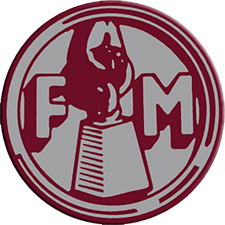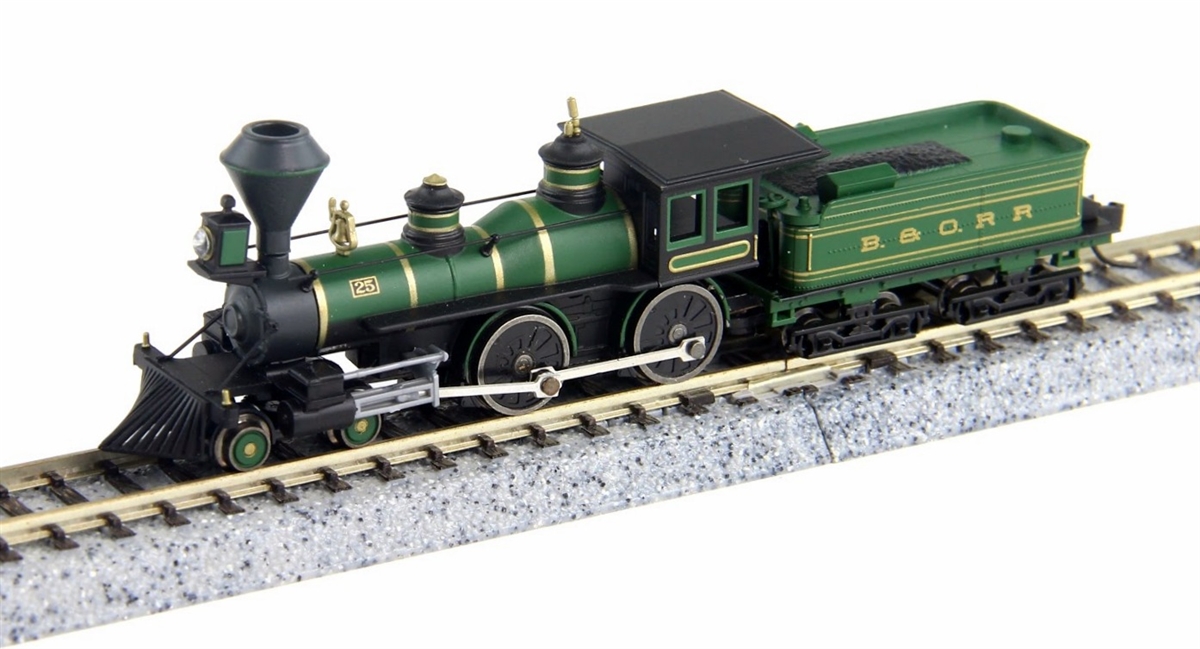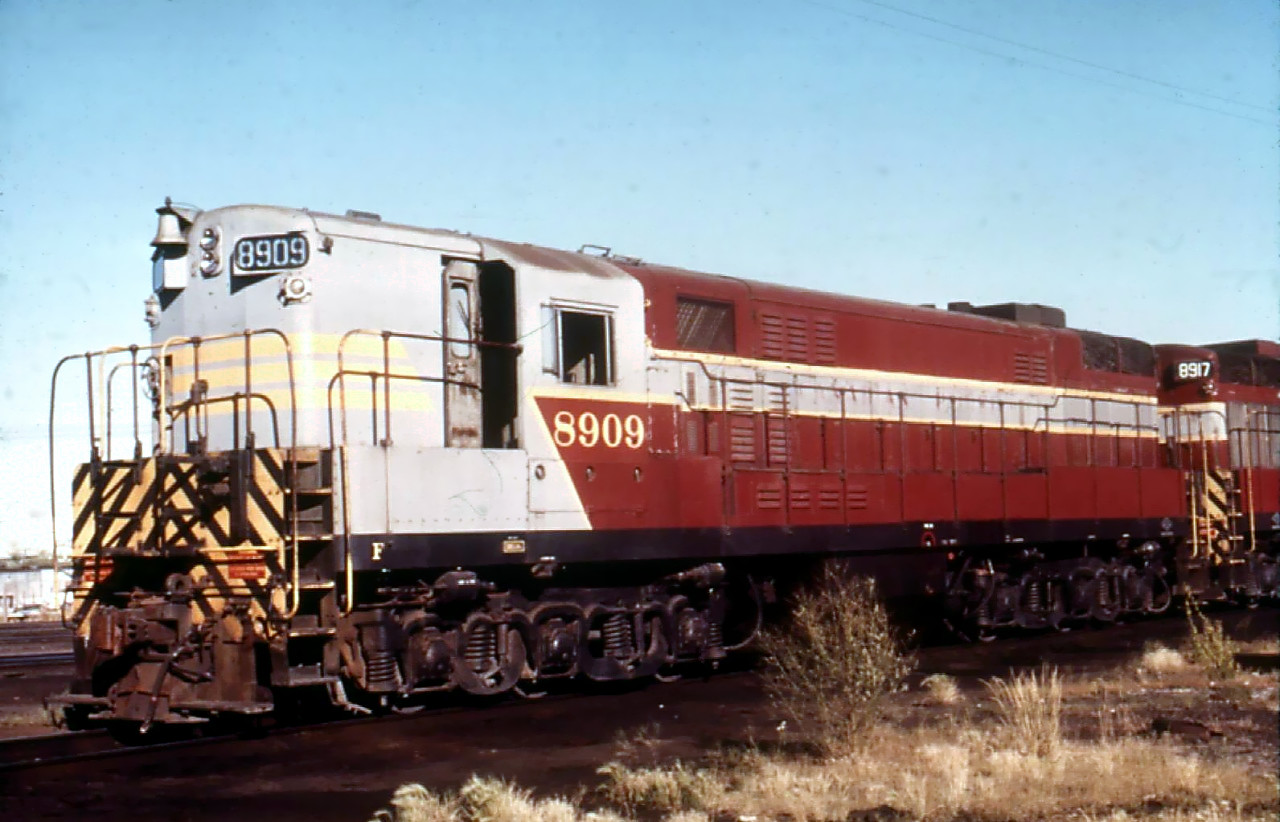Model Information: Atlas introduced its Fairbanks Morse Trainmaster model in late 2000. It is a modern mechanism with a split-frame, directional lighting, dual-flywheels, chemically blackened wheels and is drop-in decoder friendly. It has some great shell detail such as painted safety rails and etched metal grills.
DCC Information: Early versions accept a drop-in decoder.
Recent versions 'Silver Series, Sound Ready' accept ESU E24 decoders. The DC version is pre-equipped with a speaker.
Recent versions 'Silver Series, Sound Ready' accept ESU E24 decoders. The DC version is pre-equipped with a speaker.
Prototype History: The H-24-66 was a diesel-electric railway locomotive model produced by Fairbanks-Morse and its Canadian licensee, the Canadian Locomotive Company. These six-axle hood unit road switchers, nicknamed Train Masters, were deployed in the United States and Canada during the 1950s. Each locomotive produced 2,400 horsepower (1.8 MW). They were the successor to the ultimately unsuccessful Consolidated line of cab units produced by F-M and CLC in the 1950s. In common with other F-M locomotives, the Train Master units employed an opposed piston-design prime mover. The official model designation was H-24-66 and rode on a pair of drop equalized three-axle "Trimount" trucks giving it an C-C wheel arrangement.
Touted by Fairbanks-Morse as "...the most useful locomotive ever built..." upon its introduction in 1953, the 2,400 horsepower (1.8 MW) H-24-66 Train Master was the most powerful single-engine diesel locomotive available, legendary for its pulling power and rapid acceleration. While some railroads saw advantages in the Train Master's greater power, the perception on the part of others that the unit had too much horsepower (coupled with the difficulties inherent in maintaining the opposed-piston engine, inadequacies in the electrical system, and a higher-than-normal consumption of cooling water) contributed to poor marketplace acceptance of the Train Masters. Perhaps it was simply ahead of its time, as no competitor offered a locomotive with an equal horsepower rating until the ALCO RSD-7 entered production in January, 1954 (As an aside, the EMD SD24 did not arrive on the scene until July, 1958, and GE did not introduce their U25C until September, 1963). Both F-M and CLC ultimately left the locomotive business.
From Wikipedia
Touted by Fairbanks-Morse as "...the most useful locomotive ever built..." upon its introduction in 1953, the 2,400 horsepower (1.8 MW) H-24-66 Train Master was the most powerful single-engine diesel locomotive available, legendary for its pulling power and rapid acceleration. While some railroads saw advantages in the Train Master's greater power, the perception on the part of others that the unit had too much horsepower (coupled with the difficulties inherent in maintaining the opposed-piston engine, inadequacies in the electrical system, and a higher-than-normal consumption of cooling water) contributed to poor marketplace acceptance of the Train Masters. Perhaps it was simply ahead of its time, as no competitor offered a locomotive with an equal horsepower rating until the ALCO RSD-7 entered production in January, 1954 (As an aside, the EMD SD24 did not arrive on the scene until July, 1958, and GE did not introduce their U25C until September, 1963). Both F-M and CLC ultimately left the locomotive business.
From Wikipedia
Road Name History:  The Southern Pacific Transportation Company (reporting mark SP), earlier Southern Pacific Railroad and Southern Pacific Company, and usually called the Southern Pacific or (from the railroad's initials) Espee, was an American Class I railroad. It was absorbed in 1988 by the company that controlled the Denver and Rio Grande Western Railroad and eight years later became part of the Union Pacific Railroad.
The Southern Pacific Transportation Company (reporting mark SP), earlier Southern Pacific Railroad and Southern Pacific Company, and usually called the Southern Pacific or (from the railroad's initials) Espee, was an American Class I railroad. It was absorbed in 1988 by the company that controlled the Denver and Rio Grande Western Railroad and eight years later became part of the Union Pacific Railroad.
The railroad was founded as a land holding company in 1865, later acquiring the Central Pacific Railroad by lease. By 1900 the Southern Pacific Company was a major railroad system incorporating many smaller companies, such as the Texas and New Orleans Railroad and Morgan's Louisiana and Texas Railroad. It extended from New Orleans through Texas to El Paso, across New Mexico and through Tucson, to Los Angeles, through most of California, including San Francisco and Sacramento. Central Pacific lines extended east across Nevada to Ogden, Utah, and reached north through Oregon to Portland. Other subsidiaries eventually included the St. Louis Southwestern Railway (Cotton Belt), the Northwestern Pacific Railroad at 328 miles (528 km), the 1,331 miles (2,142 km) Southern Pacific Railroad of Mexico, and a variety of 3 ft (914 mm) narrow gauge routes.
In 1929 SP/T&NO operated 13848 route-miles not including Cotton Belt, whose purchase of the Golden State Route circa 1980 nearly doubled its size to 3,085 miles (4,965 km), bringing total SP/SSW mileage to around 13,508 miles (21,739 km).
By the 1980s route mileage had dropped to 10,423 miles (16,774 km), mainly due to the pruning of branch lines. In 1988 the Southern Pacific was taken over by D&RGW parent Rio Grande Industries. The combined railroad kept the Southern Pacific name due to its brand recognition in the railroad industry and with customers of both constituent railroads. Along with the addition of the SPCSL Corporation route from Chicago to St. Louis, the total length of the D&RGW/SP/SSW system was 15,959 miles (25,684 km).
By 1996 years of financial problems had dropped SP's mileage to 13,715 miles (22,072 km), and it was taken over by the Union Pacific Railroad.
Read more on Wikipedia.

The railroad was founded as a land holding company in 1865, later acquiring the Central Pacific Railroad by lease. By 1900 the Southern Pacific Company was a major railroad system incorporating many smaller companies, such as the Texas and New Orleans Railroad and Morgan's Louisiana and Texas Railroad. It extended from New Orleans through Texas to El Paso, across New Mexico and through Tucson, to Los Angeles, through most of California, including San Francisco and Sacramento. Central Pacific lines extended east across Nevada to Ogden, Utah, and reached north through Oregon to Portland. Other subsidiaries eventually included the St. Louis Southwestern Railway (Cotton Belt), the Northwestern Pacific Railroad at 328 miles (528 km), the 1,331 miles (2,142 km) Southern Pacific Railroad of Mexico, and a variety of 3 ft (914 mm) narrow gauge routes.
In 1929 SP/T&NO operated 13848 route-miles not including Cotton Belt, whose purchase of the Golden State Route circa 1980 nearly doubled its size to 3,085 miles (4,965 km), bringing total SP/SSW mileage to around 13,508 miles (21,739 km).
By the 1980s route mileage had dropped to 10,423 miles (16,774 km), mainly due to the pruning of branch lines. In 1988 the Southern Pacific was taken over by D&RGW parent Rio Grande Industries. The combined railroad kept the Southern Pacific name due to its brand recognition in the railroad industry and with customers of both constituent railroads. Along with the addition of the SPCSL Corporation route from Chicago to St. Louis, the total length of the D&RGW/SP/SSW system was 15,959 miles (25,684 km).
By 1996 years of financial problems had dropped SP's mileage to 13,715 miles (22,072 km), and it was taken over by the Union Pacific Railroad.
Read more on Wikipedia.
Brand/Importer Information: In 1924 Stephan Schaffan, Sr. founded the Atlas Tool Company in Newark, New Jersey. In 1933 his son, Stephan Schaffan, Jr., came to work for his father at the age of sixteen. Steve Jr. built model airplanes as a hobby and frequented a local hobby shop. Being an enterprising young man, he would often ask the owner if there was anything he could do to earn some extra spending money. Tired of listening to his requests, the hobby-store owner threw some model railroad track parts his way and said, "Here, see if you can improve on this".
In those days, railroad modelers had to assemble and build everything from scratch. Steve Jr. created a "switch kit" which sold so well, that the entire family worked on them in the basement at night, while doing business as usual in the machine shop during the day.
Subsequently, Steve Jr. engineered the stapling of rail to fiber track, along with inventing the first practical rail joiner and pre-assembled turnouts and flexible track. All of these products, and more, helped to popularize model railroading and assisted in the creation of a mass-market hobby. The budding entrepreneur quickly outgrew the limitations of a basement and small garage operation. Realizing they could actually make a living selling track and related products, Steve and his father had the first factory built in Hillside, New Jersey at 413 Florence Avenue in 1947. On September 30, 1949, the Atlas Tool Company was officially incorporated as a New Jersey company.
In 1985, Steve was honored posthumously for his inventions by the Model Railroad Industry Association and was inducted into the Model Railroad Industry Hall of Fame in Baltimore, Maryland. In addition, Steve was nominated and entered into the National Model Railroad Association Pioneers of Model Railroading in 1995.
In the early 1990s, the Atlas Tool Company changed its name to Atlas Model Railroad Company, Inc.
In those days, railroad modelers had to assemble and build everything from scratch. Steve Jr. created a "switch kit" which sold so well, that the entire family worked on them in the basement at night, while doing business as usual in the machine shop during the day.
Subsequently, Steve Jr. engineered the stapling of rail to fiber track, along with inventing the first practical rail joiner and pre-assembled turnouts and flexible track. All of these products, and more, helped to popularize model railroading and assisted in the creation of a mass-market hobby. The budding entrepreneur quickly outgrew the limitations of a basement and small garage operation. Realizing they could actually make a living selling track and related products, Steve and his father had the first factory built in Hillside, New Jersey at 413 Florence Avenue in 1947. On September 30, 1949, the Atlas Tool Company was officially incorporated as a New Jersey company.
In 1985, Steve was honored posthumously for his inventions by the Model Railroad Industry Association and was inducted into the Model Railroad Industry Hall of Fame in Baltimore, Maryland. In addition, Steve was nominated and entered into the National Model Railroad Association Pioneers of Model Railroading in 1995.
In the early 1990s, the Atlas Tool Company changed its name to Atlas Model Railroad Company, Inc.
Item created by: gdm on 2016-02-14 07:15:35. Last edited by gdm on 2020-06-28 10:00:34
If you see errors or missing data in this entry, please feel free to log in and edit it. Anyone with a Gmail account can log in instantly.
If you see errors or missing data in this entry, please feel free to log in and edit it. Anyone with a Gmail account can log in instantly.










